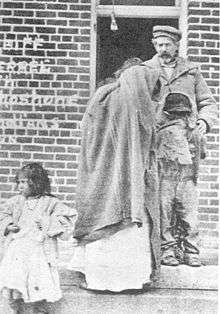Mike Daggett


Mike Daggett, or Ondongarte by birth, (unknown–February 25, 1911) was a Shoshone native American who is best known for his involvement in the Battle of Kelley Creek, during which he was killed with several members of his family. Daggett was known by many other names as well, including "Shoshone Mike", "Indian Mike", "Rock Creek Mike" and "Salmon River Mike".[1]
Background
Daggett fathered 12–13 children and is first recorded in history in 1890 when he and his family were removed from their lands on Fort Hall Indian Reservation in Idaho by settlers who claimed they had purchased the land. Twenty years later, in the spring of 1910, Daggett led his family off the reservation and they traveled to Nevada and California where they worked at various jobs.
Cattle theft
Finally, in January 1911, the Daggetts were encamped in Little High Rock Canyon in Washoe County, Nevada. Their winter stores were running low so Mike decided to steal and slaughter some cattle belonging to a local rancher.
Death and legacy
The theft did not go unnoticed and a posse of four men went to the canyon to deal with the situation, but when the four entered, Mike and two of his oldest sons ambushed the posse and killed all of them on January 19. The bodies were later found mutilated and piled inside a cave by a search party on February 8, after which a posse of Nevada and California policemen and citizens were sent to apprehend the Daggett party. On February 25, 1911, the posse discovered Shoshone Mike and his followers at a place known as Kelley Creek in Humboldt County, Nevada. During a battle that lasted three hours, Mike was killed, along with eight others, and four of his children were taken into police custody. The four later attended Stewart Indian School near Carson City, Nevada, but by 1913 only one, Dagget's baby granddaugther, was still alive.[2][3][4] She died in 1993.[5]
Notes
- ↑ Nixon, pg. 153-154
- ↑ Hickson, Howard. "Last Indian Uprising? Shoshone Mike, February 26, 1911". Great Basin College. Retrieved 2015-01-24.
- ↑ Turner Publishing Co., pg. 19-20
- ↑ Rhoads, Becky Carr (2011-11-03). "Shoshone Indian Girl Visits Casey; Last Survivor Of Tribe". Lincoln Trail Publishing. Retrieved 2015-01-24.
- ↑
References
- Nixon, Guy (2011). Slavery in the West: The Untold Story of the Slavery of Native Americans in the West. Xlibris Corporation. ISBN 1-4628-6525-9.
- Turner Publishing Co. (2003). Washoe County Sheriff's Office: dedicated service in partnership with our community. Turner Publishing Co. ISBN 1-56311-954-4.